Abstract
The literature in the field, including some stipulations of the official papers, even Law of national education, refers to only two teachers training levels: initial and continuing teachers training and, as well, give different meanings to the concept of „initial teachers training”. This is the reason the issue of teacher training levels becamed a source of controversy, misunderstanding, wrong or ambiguous formulations in legislative documents, and in some written or public statements. In order to provide a new look on teachers training, the authors demonstrate that the Romanian Teachers Training System (RTTS model) is built on four levels of training: the initial teacher training, obtained during the first cycle of the university studies, the in-depth teacher training, realized during the second cycle of the university studies (by professional and educational master), the advanced/doctoral training and the continuing teachers training. Each of them highlights the teachers competence development and the increase in the professional qualification level. Each level has a relative autonomy, being conditioned by prior attainments. That framework (RTTS) help us analyze and better understand the actual debates on teachers training; as well, it can hopefully serve as a conceptual tool for decision-makers, teachers and other people and organizations interested in teachers training process to more quickly understand and utilize the key concepts involved. Romania has a modern and complex structure of the teachers training system, but it is necessary to transform it into a scientific and methodological working system to improve the teachers professional and pedagogical competences.
Keywords: Teachers traininguniversity studiesteachers professional development
1.Introduction
In the last 5 years, there were more than 5 legal documents, a lot of national debates, publications
and public depositions on teachers training. It seems to us that, nowadays, teachers training becomes a
complex, noisy, and a jumbled environment.
Trying to discern what is really crucial about it, to see what patterns are emerging and what the
underlying cause and effect relationships are, we found that, in the period 2011-2016,
makers and educational managers thought and behaved mostly as functional tacticians than as a
complex environments, and are able to crystallize and communicate the strategic implications to others.
Tacticians, on the other hand, must focus on the details of how best to implement an overall strategy.
These implementation decisions are often the responsibility of functional leaders. Both strategy and
tactics are important” (Watkins, 2014).
2.Problem Statement
The literature in the field, including some stipulations of the official papers and of Law of national
education (no.1/2011, actualized at 2.10.2015), refers to only two teachers training levels: initial and
continuing teachers training and, as well, give different meanings to the concept of „initial teacher
training”. This is the reason the issue of teacher training level becamed a source of controversy,
misunderstanding, wrong or ambiguous formulations in legislative documents and in some written or
public statements (National debate ”Romania-Educated”, 21.04.2016).
3.Purpose of the Study
The study presents new ways of considering existing information about the teachers training.
In order to provide a new look on teachers training in Romania, the authors try to identify:
A. The levels of Romanian Teachers Training System (RTTS) the Law of national education,
no.1/2011 refers to;
B. Some implications of applying RTTS model on the political and educational decisions and
discourses on teachers training;
4. Research Methods
The study is based on the following research activities:
Content analysis of the Law of national education no.1/2011 (actualized at 2.11.2015) and of other legislative documents on teacher training; besides, the authors have experienced, in over 40 years of university teaching - researching activities, all situations arising from legislative changes that have occurred in connection with teachers training;
Processing and interpretation of 133 public testimonies/depositions presented at national debate "Romania - Educated” organized on 21.04.2016, (available on the Debate sites, 2016);
Interviews with 30 teachers, on their professional training and portfolios (June, 2016).
5. Findings
5.1. The levels of Romanian Teachers Training System (RTTS) the Law of national education
1/2011 refers to. Between official documents and reality.
A1. In our view, Romania has a modern and reasonable teachers training system; its
components can be described as ”The Big Four Levels”.
These Big Four Levels of the Romanian Teachers Training System are: the initial, the in-depth, the
advanced and the continuing teachers training (Fig.1):
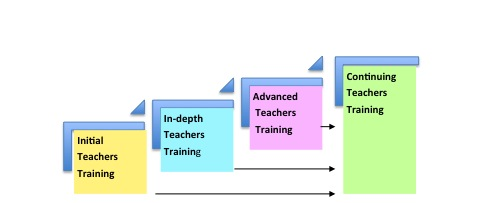
Surprisingly, this idea is not stipulated in the Law of national education, no.1/2011(actualized,
2015) when refere to teachers training. Our framework emerged out as a necessity to better clarify
and
understand the actual debates on teachers training; as well, it can hopefully serve as a conceptual tool for
decision-makers, teachers and other people and organizations interested in teachers training process to
more quickly understand and utilise the key concepts involved. It is both self-explanatory and transparent
so that even the bachelor student can readily make sense of it.( Fig.2).
assure the initial teachers training and, according to the Law of education, no.1/2011, gives the right to
become teacher in preschool, primary and secondary education in the following two situations:
a) Bachelor graduate of one of the following 6 degree Bachelor programs (Bachelor T): Primary
education and preschool Pedagogy, Pedagogy, Music Pedagogy, Teaching Theology, Pedagogy and
decorative arts. (Law of education, art.238 (7, 13) and art.248 (d, e);
b) Bachelor graduate and certified Level 1 Pedagogical training (Bachelor + P1) (Law of
education, art. 248 (f, g).
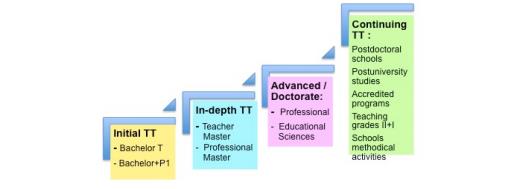
studies, through the teaching master and professional master programs, the ISCED level 7. ”Entry into
ISCED level 7 programmes, preparing for a second or further degree, normally requires the successful
completion of an ISCED level 6 or 7 programme”. (UNESCO-UIS, 2012; EU/EACEA, 2015).
The level
professional or speciality doctorate, some european universities being already engaged in an EU Project
on
unifying principles for the design, organization and development of an european doctoral study
programmes in teacher education. (Iucu & Schratz, 2013; EDiTE, 2016). As a rigorous form of advanced
academic apprenticeship and learning, doctoral education ”continues to evolve from an elite activity,
focused mainly on acting as a pipeline for future research professors structured around strict disciplinary
boundaries, towards more interdisciplinary programmes that prepare students for a variety of positions in
and out of academia”. (Blessinger, 2016).
The alumni of each of those three levels of RTTS can continue their professional and individual
development attending different types of programes offered by an institutionalized postgraduate study
level, continuing teachers training.
It must be observed that:
each level of teachers training has its autonomy, indicates distinct targets and specialized training processes, as well as specific assessment processes and accreditation standards (ARACIS, 2015);
each of the four levels of teachers training is, as a matter of fact, a strategic target for professional development, both in terms of teacher and school organization. Moreover, they are even considered by regular national assessment of the quality of education provided by primary and secondary schools (ARACIP), as well as in the professional evaluation of each teacher, the evidences being components of professional portfolio.
A.2.The RTTS model is in compliance with the national and European policies on university
studies cycles and on qualifications description:
• the structural component, in line with the Bologna process, focuses on three of the eight levels of
qualification, namely: Bachelor university studies, corresponding to EQF level 6, Master’s
university studies, corresponding to EQF level 7 and doctoral university studies, corresponding
to EQF level 8;
• =it is based on the analysis of relevant theories and research outcomes in the fields of education
sciences, psychology of learning, psychology of labor, with special reference to standards,
curriculum design models, competence development and assessment systems and procedures;
• =it also takes into account the social and group context of practicing the teaching profession, as
well as the awareness of the continuing teachers training need.
Romania has a modern and complex teachers training system, but it is necessary to transform it into
a scientific and methodological working system to improve the professional and pedagogical
competences of the teachers.
5.2. Implications of applying the RTTS model
B.1.There are differences in assigning importance to four specific academic areas of teachers
training process.
Unfortunately, considering the Law of education, there are references (Fig. 3) to only two of the
four levels identified: to the initial and to the continuing teachers training (e.g.: the Law 1/2011,
art.232 (2): ”Teaching Staff Statute governs initial and continuing training"; the title of the Second
section is: "Initial and continuing training" ); as well, "Development of human resources in schools
education aims: initial teacher training, continuing training of teaching staff" (see www.edu.ro).
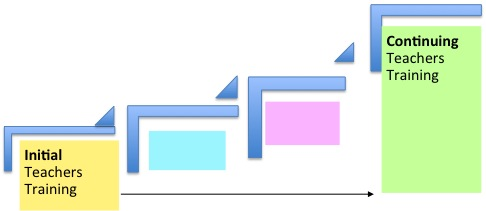
B.2.The concept of ”initial teachers training” swallows on the ”in - depth teachers training”.
The literature in the field, including some stipulations of the official papers, gives different
meanings to the concept of „initial training”. When refere to pycho-pedagogical training, the Law
(1/2011, actualized 2015, art. 236) stipulates: ”Initial training for teaching positions in secondary
education includes: completing the master teacher with 2-year
and university graduates who opt for teaching profession are required to graduate from a master teacher
with 2-year
is completed by obtaining a master's degree
training programs”. (Fig.4).
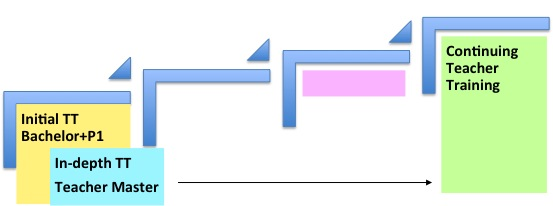
In such a conditions, it is of high probability that educational politics differs significantly on how
they understand and use the main concepts utilized: teacher training system, levels of teachers
professional competences, especially ”initial training” and ”in-depth training” (master).
As an exemplification of this, let us to prezent the opinions made public at anational debate,
organized quite recently (National Debate
After processing the data provided by 133 depositions (27 - audio / video and 106 - affidavits,
available on the websites: www.coalitiaedu.ro and
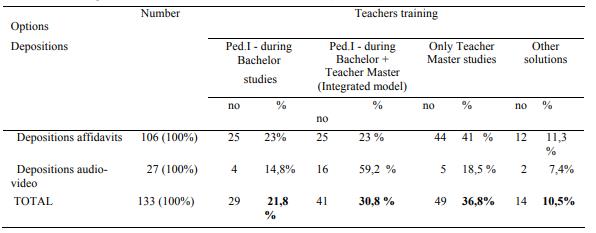
52,6% (70 of 133 depositions) refere to the initial teachers training during the first cycle of
university studies, Bachelor + pedagogical Level 1(P1). To be observed, 58,5% (41/70) of
deposits have proposed a new model for professionalization of teaching staff, amodel (Toma,
Potolea, 2014) that
studies, namely, teaching master.
But,
36,8% (43 individuals and 6 organizations) consider that only the teacher in-depth
training/master programme assures the initial teachers training! It is the same mistake the
art.236, paragraph 1 of the Law no.1/2011 done by integrating GEO no.49/ 2014, which states
that the initial training provided by Law to article 238, paragaph 1, shall be made
skills development program for the teaching career ",
no 49/2014).
Those depositions, as well the title of the National Debate,
mode (1+2)? What kind of initial training will increase the quality in the education system in
master (in-depth teachers training). Teacher Master is again, all correlated only with the initial training. A
parallel drawn between the two initial routes to professionalize teaching showed that they may not be
considered equivalent
The idea to place the Teacher Master in relation to the initial pedagogical training is
inconsistent with the idea promoted by the "Bologna Process" and the Law no. 2004 on the
organization of university that stipulates: "Master studies provide
undergraduate studies or in a area near capacity for scientific research and is a compulsory basis
for doctoral studies "(Law no.288/2004, art. 9, paragraph 2).
As well, it is known that the first principle of logic - the principle of identity - asks that, in the
same speech, it is compulsory to use terms with similar meaning. Serious breaches of this
principle creates confusion and harms speech clarity. In our case, the concept of master once
defined by european documents and national legislature as ”Second or further degree, following
successful completion of a Bachelor’s or equivalent programme” (UNESCO-UIS, 2012;
EU/EACEA/Eurydice, 2015)) that mean must be observed throughout the text of the law and
documents elaborated later under them: ordinances, methodologies, etc. Add to this, someone
can observe the violation of the noncontradiction principle: term master is used to mean both
initial training as well as in-depth training.
Finally, if we want things well done, it is very important that all documents that regulate an
area have to be clearly formulated and articulated coherent, otherwise the actors will move
confusing and messy.
6. Conclusions
a) In line with the Bologna Process, Romanian Teachers Training System was established under
Law no.288/2004. In the following pieces of legislation / regulations, systemic approach has remained
somewhat implicit, in the foreground are removing a component or another, mainly initial and continuing
training. Even top-level forms (master) has been subsumed initial training.
This is the reason the issue of teacher training levels becamed a source of controversy,
misunderstanding, wrong or ambiguous formulations in legislative documents and in some written or
public statements (educational managers, universities, school inspectorates, educational institutions,
NGOs etc.).
We found that the Romanian Teachers Training System (RTTS) exists but references to it are not
unitary. The various components are unevenly considered, some even neglected from year to year,
prioritizing others. The decision-makers have developed tactics (orders, regulations, methodologies,
guidelines etc.) on topical issues, strategies drawn out, missing the big picture. In terms of frequently
changing leadership, measures could only be tactical and largely inconsistent. It was enough in 2016 to
raise the issue in exactly the terms before 2004 (Bologna Process)! So, it is desirable for decision-makers
to realize the existence and the potential of this model with the more so as many foreign experts have
recognized that, in some respects, Romanian Teachers Training System can inspire other education
systems. "Every EU country that wants to develop a TCPD (teacher continuing professional
development) regulated by framing should consider the Romanian experience"(Janecke & Mykytyn,
2007).
b) The Romanian Teachers Training System levels must to be clearly stipulated by the Law of
national education.
The framework identified (RTTS) is a conceptual model of professional teachers development and,
as well, a multi-process dynamic model that allows each teacher to develop an individualized plan of
teaching career.
The ”big four levels” of the Romanian Teachers Training System represent the specific points of
teacher’s professional and personal development. Training and professional development of teaching staff
and the management, guidance and control is in Romania, a professional field, distinct and crystallized
from a conceptual perspective, but it requires a political document that defines unequivocally system
components and their relationships (defined methodologies and functions).
c) The initial training for a teaching career must be carried out during the first cycle of the university
studies. Master Teacher training, as in-depth pedagogical training, should enable teachers to further
university teaching career. The programs provided by each of those levels has distinct finality, number of
credits, curriculum, different types of certification and different standards of accreditation (ARACIS,
2015). Obtaining a teacher master has to signify the access to teaching grade I, according to the status,
roles and competencies associated with the teaching profession.
d) Romania has a modern and complex teachers training system, but it is necessary to transform it
into a scientific and methodological working system to improve the professional and pedagogical
competences of the teachers.
References
- ***ARACIS (2015). Standarde specifice pentru acreditarea masteratului didactic http://www.aracis.ro/uploads/media/Standarde_specifice__Stiinte_administrative__ale_educatiei_si_psih
- olog ie_2015.pdf (available at 1.10.2016).
- Blessinger, P.,(2016). The shifting landscape of doctoral education, University World News, 07 Oct.
- 2016, Issue
- No:431, http://www.universityworldnews.com/article.php?story=20161004145514435 (available at
- 1.10.2016)
- ***GEO 49/2014. Ordonanta de Urgență nr. 49/2014 privind instituirea unor măsuri în domeniul educației, cercetării științifice și pentru modificarea unor acte normative, Monitorul Oficial, Part I, nr. 486/30.06.2014.
- ***EDiTE – European Doctorate in Teacher Education. Second cycle (01.10.2015-30.09.2019), Horizon 2020 founded project (H2020-MSCA-ITN-2015), http://www.edite.eu/2012-2014/edite_project/PHILOSOPHY (available at 1.10.2016).
- ***European Commission/EACEA/Eurydice (2015). The Structure of the European Education Systems 2015/16:
- Schematic Diagrams. Eurydice Facts and Figures. Luxembourg: Publications Office of the European
- Union.
- p.10. http://ec.europa.eu/eurydice (available at 1.10.2016).
- Iucu, R, Schratz, M., (2013) European Doctorate in Teacher Education, on the The 9th International ScientificConference ELSE for Education, Bucharest ISI Proceeding, ISI Thomson Data Base, April 2013 Janecke, B.,Mykytyn, I.(2007), Summary Report. Comparative Analysis on In-Service Teacher Training Systems in Europe, WYG-international, Bucharest. Ed. Atelier didactic, p.66 ***Law no. 288/2004 on university studies, Monitorul Oficial, I, no. 614 / 7.07.2004, www.aracis.ro/cadrul-legislativ/ (available at 1.10.2016).
- ***Law of national education. Law no. 1/2011, Monitorul Oficial, Part I, no.18 / 10.01.2011, actualized and republished, 2.10.2015), www.aracis.ro/cadrul-legislativ/ (available at 1.10.2016).
- ***National Debate ”Romania-Educated” (2016). Teacher Master or psycho-pedagogical mode (1+2)?, Bucharest, 21.04.2016, www.coalitiaedu.ro ; www.privesc.eu/Arhiva/66726/Audiere-Publica–Formarea-initiala-a-profesorilor (available at 1.10.2016).
- Toma, S., Potolea, D. (2015). Masteratul didactic – Statut profesional, Perspective pentru cercetarea în educație, (ed.S.Sava), Bucharest, Ed.Universitaria, pp. 130-139.
- ***UNESCO - Institute for Statistics (UIS), (2012). International Standard Classification of Education ISCED 2011, pp.55-58, http://www.uis.unesco.org/Education/Documents/isced-2011-en.pdf (available at 1.10.2016).
- Watkins, D.M. (2014), From tactician to strategist, Step three in the transition from functional to business leadership,October 2014, (http://www.imd.org/research/challenges/TC080-14-tactician-strategist-michael- watkins.cfm?MRK_CMPG_SOURCE=webletter-issue09-14&utm_source=DM (available at 1.10.2016).
Copyright information

This work is licensed under a Creative Commons Attribution-NonCommercial-NoDerivatives 4.0 International License.
About this article
Publication Date
25 May 2017
Article Doi
eBook ISBN
978-1-80296-022-8
Publisher
Future Academy
Volume
23
Print ISBN (optional)
-
Edition Number
1st Edition
Pages
1-2032
Subjects
Educational strategies, educational policy, organization of education, management of education, teacher, teacher training
Cite this article as:
Toma, S., & Potolea, D. (2017). The Big Four Levels Of The Romanian Teachers Training System. In E. Soare, & C. Langa (Eds.), Education Facing Contemporary World Issues, vol 23. European Proceedings of Social and Behavioural Sciences (pp. 142-150). Future Academy. https://doi.org/10.15405/epsbs.2017.05.02.19

